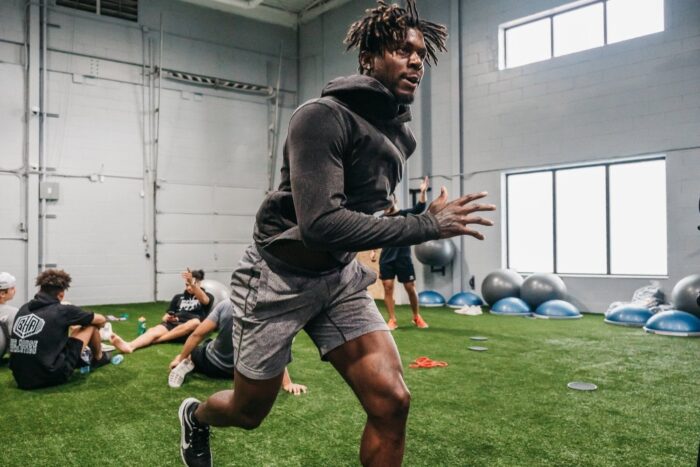In the competitive realm of sports, achieving high performance is the pinnacle of success for athletes and coaches alike. This achievement is not just a product of talent or willpower but rather the result of meticulously planned and executed training strategies. These strategies encompass a comprehensive understanding of physiology, psychology, nutrition, and technology’s role in optimizing an athlete’s performance.
This article explores the secrets of high-performance training in sports.
The Role of Technology in Enhancing Training

Source: stickymodern.com
Advancements in sports science have greatly influenced high-performance training. Among these, gait analysis is a pivotal tool for athletes, especially in disciplines like running, cycling, and team sports. It’s important to understand how this technology provides invaluable insights into an athlete’s movement, enabling tailored training regimens that enhance efficiency and reduce injury risks.
Particularly crucial in activities like running, cycling, and team sports, gait analysis utilizes sophisticated equipment and software to capture and analyze movement patterns. This technology offers a window into the nuances of an athlete’s stride, foot placement, and overall body mechanics.
By scrutinizing these elements, coaches and trainers can develop highly customized training programs. These programs aim to boost an athlete’s efficiency and speed and play a significant role in minimizing the risk of injuries.
With such detailed insight, gait analysis can help fine-tune an athlete’s technique, ensuring that every motion contributes positively to their overall performance and longevity. However, if coaches and trainers want to learn more about gait analysis, they can check out reliable websites and online resources.
Comprehensive Physical Conditioning

Source: trainheroic.com
Comprehensive physical conditioning is the cornerstone of high-performance training in sports. It encompasses a holistic approach to preparing the athlete’s body for the rigors of their sport, focusing on enhancing strength, endurance, flexibility, and mobility. Some essential aspects of comprehensive physical conditioning include:
- Strength and Endurance Training
Strength and endurance training form the bedrock of an athlete’s physical conditioning. It’s not just about building muscle mass but also enhancing muscular endurance. Athletes engage in weight training to develop strength, while cardiovascular exercises boost their stamina.
Additionally, sport-specific drills are integrated to simulate real-game scenarios. This combination ensures athletes are equipped with the power and endurance needed for peak performance, enabling them to sustain high activity levels over extended periods.
- Flexibility and Mobility
Flexibility and mobility are essential for an athlete’s overall physical health and performance. Training in these areas involves more than simple stretching; it includes a variety of exercises like yoga, dynamic stretching, and pilates. These activities enhance the elasticity of muscles and the range of motion in joints.
By focusing on flexibility and mobility, athletes can improve their performance, reduce the likelihood of injuries, and extend their careers. These practices are vital in ensuring athletes’ bodies can withstand the demands of high-level competition and recover more effectively.
Nutritional Strategies for Peak Performance

Source: intechhpt.com
Optimal nutrition is a key factor in an athlete’s performance and recovery. Tailoring a diet to meet the specific energy and recuperation demands of high-performance training is crucial. Athletes require a balanced intake of proteins for muscle repair, carbohydrates for sustained energy, and essential fats for overall health. Equally important is hydration, a critical component often overlooked. Effective hydration strategies maintain performance levels and aid in recovery and thermoregulation.
By carefully managing their nutritional intake, athletes can significantly enhance their performance, endurance, and recovery, ensuring they are always at their competitive best.
Mental Toughness and Psychological Preparation
High-level sports demands more than physical prowess; it requires robust mental strength. Developing mental toughness and resilience is integral to an athlete’s success. Techniques like visualization, meditation, and goal-setting are pivotal in this mental conditioning. Through visualization, athletes mentally rehearse their performance, enhancing focus and confidence. Meditation aids in stress management and maintaining a clear mind, while goal-setting provides motivation and direction.
Working alongside coaches and sports psychologists, athletes can cultivate a mindset that enables them to overcome challenges, maintain focus under pressure, and harness a positive attitude, all of which are crucial for excelling in competitive environments.
Recovery and Injury Prevention

Source: advancedboneandjoint.com
In the rigorous world of high-performance sports, recovery and injury prevention are just as vital as the training. The following aspects play a crucial role in an athlete’s longevity and continual ability to perform at their best:
-
Importance of Rest and Recovery
Rest and recovery are foundational to an athlete’s training regimen. High-performance athletes engage in structured rest protocols, understanding that the body needs time to heal and strengthen after intense physical exertion. This includes prioritizing adequate sleep, essential for muscle repair and cognitive function.
Moreover, rest days are incorporated into training schedules to allow full recovery. Active recovery methods are also employed, such as light cardio exercises or swimming. These activities facilitate blood circulation, aiding muscle recovery and reducing stiffness, ensuring athletes are prepared for subsequent training sessions.
-
Injury Prevention Strategies
Injury prevention is a strategic component of high-performance training. Athletes adopt comprehensive measures to safeguard against injuries, which can be detrimental to their careers. This includes proper warm-up and cool-down routines, which prepare the body for physical exertion and aid post-exercise recovery. Using appropriate protective gear specific to their sport is also crucial in minimizing the risk of injuries.
Furthermore, athletes and coaches adhere to safety protocols during training and competitions. These strategies prevent acute injuries and help avoid long-term wear and tear, ensuring athletes can maintain peak performance over time.
Continuous Evaluation and Adaptation
Continuous evaluation and adaptation are pivotal in the realm of high-performance training. This dynamic process involves regular assessment of an athlete’s progress through various performance metrics, including physical tests, skill assessments, and competitive results. Feedback from coaches and trainers is invaluable, providing insights into areas needing improvement or adjustment.
Health assessments also play a crucial role, ensuring that the athlete’s physical and mental well-being are aligned with their training demands. These evaluations enable a responsive approach to training, allowing for modifications in techniques, intensity, and focus areas. This adaptability ensures that training remains effective, relevant, and aligned with the athlete’s growth and the ever-changing landscape of their sport.
Conclusion: The Path to Excellence in Sports
The journey to high performance in sports is multifaceted, demanding a blend of physical prowess, mental strength, technological support, and strategic recovery. By understanding and implementing these components, athletes and coaches can unlock the full potential of their abilities, paving the way for remarkable achievements in the world of sports.
